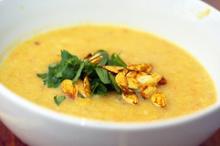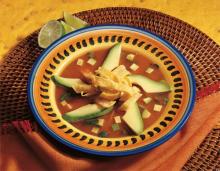I was utterly charmed to learn that Chinese traditional medicine has
dietary suggestions for each season. It takes the Western truisms like "salad in summer" and "soup in winter" to a whole new level.
Unlike Western "neutraceutical" practices, Chinese traditional medicine does not advocate taking a whole lot of any given thing, or taking it for very long. Each food has an ideal season when it should be eaten, but even so, you should never eat too much of it.
According to traditional Chinese medicine, fall is the season when the chi begins to drop, and the yin (feminine) energy rises in preparation for winter. This is the season that is ruled by the lungs and colon. As a result, people are likely to suffer from constipation and grief.
Grief? That's right: your lungs are said to be the repository of grief. As fall deepens into winter, your body has to experience a "letting go." This release of grief from the lungs causes sadness, and sometimes a dry cough.
(I never claimed to understand traditional Chinese medicine. It sure is interesting, though!)
To ground yourself with the seasons and build up your energy for winter, eat root vegetables and tubers like carrots, turnips, and beets. Gourds like squash and pumpkin are also recommended, as are seeds (including sunflower seeds, sesame seeds, and pumpkin seeds).
To counteract fall's tendency to be
cool and dry, choose foods which are sour. Lemon juice, apples, grapefruit, pickles, pears, sauerkraut, borscht, and pineapple are all included on this list. The sourness… I don't know, it's something about the spleen. Just go with it.
Soups, porridges, and teas are all excellent additions to your fall menu. These warm fluids help your body retain moisture which is sapped by the cool, dry, often windy weather.
The skeptic observer might note that Chinese food medicine is all about eating fresh, seasonal, local ingredients, and avoiding foods that are fatty, fried, or sugary. Such a skeptic might also point out that by rotating food theories in each season, one is more likely to get a broad spectrum of nutrition.
Frankly, none of this is any wackier than Western beliefs in the miraculous power of turkey to make you sleepy (a myth), or in faddish cure-alls like pomegranate, cutting out all carbs, or lemon maple syrup "cleanse" diets.
Some ideas for fall recipes using ingredients recommended by traditional Chinese medicine:
* A seasonal fungus recommendation is the white fungus (tremella) which goes by a number of different names. I found a recipe for white fungus soup that looks absolutely delicious!
* Green tea with lemon is a great cure for cold damp weather. I made a pot of green tea with lemon this afternoon, and it totally worked! (Really, is there anything better on a cold, wet day?)
* A delicious fall salad garnished with chunks of apple and sunflower seeds, and dressed with a raspberry or grapefruit vinaigrette.
* Pumpkin or butternut squash soup; garnish each bowl with a generous dollop of sour cream or tart unsweetened yogurt, plus a sprinkle of toasted pumpkin seeds.
* Fall fruit salad with apples, pears, pineapple, grapefruit, and a dash of lemon juice.
Photo credit: Flickr/sassyradish









